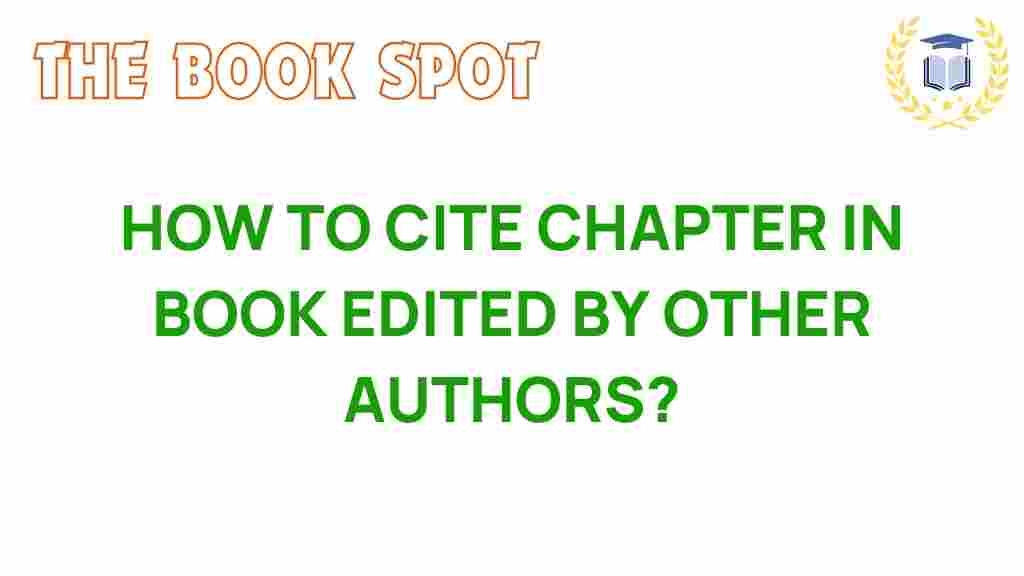Mastering the Art of Citation: How to Reference Book Chapters
In the realm of academic writing, the ability to correctly reference sources is crucial. Among these sources, book chapters often hold significant value, especially in edited volumes where multiple authors contribute to a single topic. Mastering the art of citation not only enhances the credibility of your research but also helps avoid plagiarism. This article aims to provide a comprehensive guide on how to reference book chapters effectively, adhering to various style guides and author guidelines.
The Importance of Citation in Academic Writing
Citation serves several important functions in research and scholarly articles. Here are some key reasons why it is essential:
- Credibility: Properly citing sources lends authority to your work.
- Traceability: Readers can locate the original sources for further investigation.
- Academic Integrity: Citing sources helps you maintain ethical standards in your writing.
- Engagement with Existing Literature: References showcase your awareness of the field.
Understanding how to reference book chapters is a fundamental skill for any academic, and it is essential to follow the appropriate guidelines for your specific discipline.
How to Reference Book Chapters: A Step-by-Step Process
Step 1: Identify the Required Citation Style
Different academic fields prefer different style guides. Common ones include:
- APA (American Psychological Association): Frequently used in social sciences.
- MLA (Modern Language Association): Common in humanities.
- Chicago/Turabian: Often used in history and some other disciplines.
- Harvard: Popular in many fields, especially in the UK.
Each of these styles has specific rules for referencing book chapters. Ensure you know which style is required before proceeding.
Step 2: Gather Necessary Information
For referencing a book chapter, you will need the following information:
- Author(s) of the chapter
- Title of the chapter
- Editor(s) of the book
- Title of the book
- Publisher
- Year of publication
- Page range of the chapter
Make sure to note the details accurately as they will be crucial for proper referencing.
Step 3: Format Your Citation According to the Style Guide
Below are examples of how to cite a book chapter in different styles.
1. APA Style
Format:
Author(s). (Year). Title of the chapter. In Editor(s) (Eds.), Title of the book (pp. pages). Publisher.
Example:
Smith, J. A. (2020). Understanding citation styles. In R. Brown & T. Wilson (Eds.), Academic Writing Today (pp. 45-67). Academic Press.
2. MLA Style
Format:
Author(s). "Title of the Chapter." Title of the Book, edited by Editor(s), Publisher, Year, pp. pages.
Example:
Smith, John A. "Understanding Citation Styles." Academic Writing Today, edited by Robert Brown and Thomas Wilson, Academic Press, 2020, pp. 45-67.
3. Chicago/Turabian Style
Format:
Author(s). "Title of the Chapter." In Title of the Book, edited by Editor(s), pages. Publisher, Year.
Example:
Smith, John A. "Understanding Citation Styles." In Academic Writing Today, edited by Robert Brown and Thomas Wilson, 45-67. Academic Press, 2020.
4. Harvard Style
Format:
Author(s), Year. Title of the chapter. In: Editor(s), ed(s). Title of the book. Place of publication: Publisher, pp. pages.
Example:
Smith, J.A., 2020. Understanding citation styles. In: Brown, R. and Wilson, T., eds. Academic Writing Today. New York: Academic Press, pp. 45-67.
Step 4: Include In-Text Citations
In addition to the reference list, you must include in-text citations that correspond to your references. The format varies by style:
- APA: (Smith, 2020)
- MLA: (Smith 45)
- Chicago: (Smith 2020, 45)
- Harvard: (Smith 2020, p. 45)
Ensure you follow the correct format as per your chosen style guide.
Troubleshooting Common Citation Issues
Even seasoned academics encounter challenges when citing sources. Here are some common issues and how to resolve them:
1. Missing Information
If you cannot find certain details, such as the editor’s name or page range, check the book’s front matter or online library catalogs. If the information is still unavailable, follow the style guide’s instructions for such cases.
2. Multiple Authors
For chapters with multiple authors, ensure you list all authors up to a certain number, as specified by the style guide. For instance, APA allows up to 20 authors to be listed before using “et al.”
3. Different Editions
If you are referencing a chapter from a different edition of a book, make sure to specify the edition in your citation. This helps maintain accuracy in your references.
4. Electronic Sources
When referencing chapters from e-books or online versions, include the DOI or stable URL as per the style guides you are following.
5. Style Guide Confusion
If you find yourself confused about which style to use, consult your professor or refer to the author guidelines provided by your institution or publisher. Most academic institutions have a preferred style, which simplifies your decision.
Conclusion
Mastering the art of citation is an essential skill for anyone engaged in academic writing. Properly referencing book chapters not only enhances the integrity of your work but also contributes significantly to the scholarly community. By following the outlined steps and adhering to your chosen style guide, you can ensure that your citations are accurate and complete.
Remember, the goal of citing sources is not just to follow rules; it is to honor the contributions of other scholars and to engage meaningfully with the existing body of knowledge. With practice, you will become proficient in referencing book chapters and other sources, setting a solid foundation for your research and writing endeavors.
For more tips on academic writing and citation practices, feel free to explore our other articles or visit scholarly resources that can support your learning journey.
This article is in the category Guides and created by TheBookSpot Team
